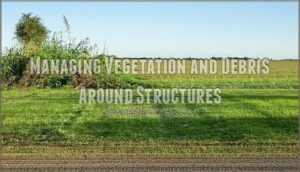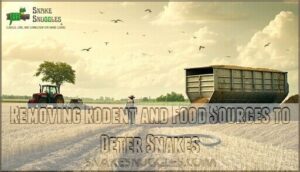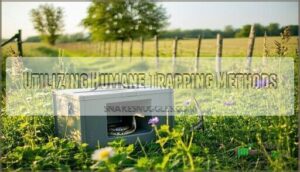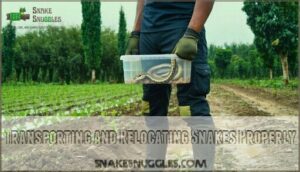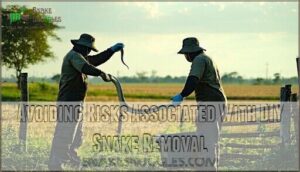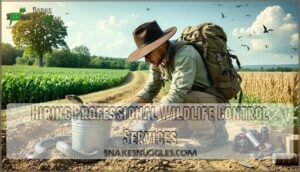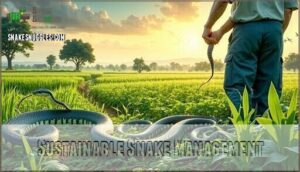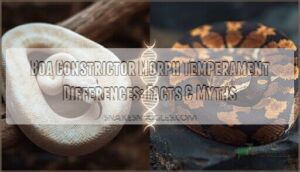This site is supported by our readers. We may earn a commission, at no cost to you, if you purchase through links.
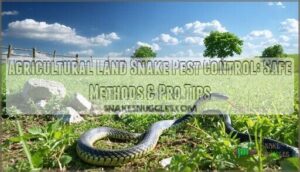
You’ll need to identify venomous species that pose genuine threats while preserving beneficial snakes that control crop-damaging rodents.
Focus on habitat modification by removing debris piles, managing vegetation, and eliminating rodent food sources rather than relying solely on chemical deterrents.
Snake-proof fencing around critical areas and proper storage practices substantially reduce encounters.
Professional identification proves essential—what looks threatening might actually be your farm’s best pest control ally.
Smart farmers know that understanding snake behavior and implementing targeted exclusion methods creates safer working conditions while maintaining nature’s balance.
Table Of Contents
- Key Takeaways
- Snake Control Methods
- Securing Agricultural Land
- Safe Snake Removal
- Snake Repellents and Deterrents
- Sustainable Snake Management
- Frequently Asked Questions (FAQs)
- How to get rid of snakes in farms?
- Do pest control companies get rid of snakes?
- What is the best snake for pest control?
- How much does pest control charge to remove snakes?
- What are the common snake species in my region?
- How can I prevent snakes from entering my farmland?
- What are the safety precautions for handling venomous snakes?
- Are there any natural methods to deter snakes from my property?
- How can I educate my employees about snake identification and management?
- What snakes naturally control agricultural pests effectively?
- Conclusion
Key Takeaways
- Identify beneficial snakes first – You’ll protect your farm’s natural pest control by distinguishing harmless rodent-eating species from genuinely dangerous ones before taking any removal action.
- Focus on habitat modification over chemicals – You’ll achieve better results by removing debris piles, sealing entry points, and eliminating rodent food sources rather than relying on unproven chemical repellents.
- Install proper barriers strategically – You’ll prevent 90% of snake encounters by using snake-proof fencing with welded wire mesh and underground extensions around critical farm areas.
- Embrace sustainable management practices – You’ll maximize crop protection by working with beneficial snake populations that consume thousands of crop-damaging rodents annually while using targeted exclusion only where necessary.
Snake Control Methods
When you encounter snakes on your agricultural property, proper identification becomes your first line of defense against potential dangers.
You’ll need to distinguish between beneficial pest-controlling species and those that pose genuine safety risks before taking any management action, which involves understanding the potential dangers.
Identifying Venomous Vs. Non-venomous Snakes
Distinguishing venomous from non-venomous snakes requires careful observation of key physical characteristics and behavioral patterns.
Proper snake identification protects you from dangerous encounters while maintaining effective agricultural pest control on your farm property.
**Smart identification safeguards your farm while preserving nature’s pest controllers.
- Head shape: Venomous species typically display triangular, wedge-shaped heads with prominent necks, while non-venomous snakes have rounded or oval heads
- Pupil structure: Pit vipers exhibit vertical, cat-like pupils compared to the round pupils found in most harmless species
- Facial features: Heat-sensing loreal pits between eyes and nostrils indicate venomous pit vipers, though coral snakes lack these specialized organs
- Defensive displays: Rattling tails, gaping white mouths (cottonmouths), and aggressive posturing signal venomous characteristics requiring immediate caution
Recognizing Different Snake Species in Agricultural Areas
Agricultural ecosystems host diverse snake species, each requiring specific identification techniques.
Rat snakes climb vegetation with slender bodies, while Russell’s vipers display triangular heads and distinctive patterns. Eastern brown snakes dominate Australian farmlands, contributing substantially to pest control through rodent consumption.
Understanding regional snake behavior patterns helps farmers distinguish beneficial species from potentially dangerous ones during peak agricultural seasons.
Accurate snake identification involves understanding key characteristics, such as snake species traits, to guarantee effective and safe control methods.
Seeking Professional Assistance for Snake Identification
When you can’t tell one snake from another, it’s time to call in the professionals.
Snake Experts provide essential Species Recognition services that keep you safe while protecting beneficial wildlife on your property.
Here’s when Professional Guidance becomes necessary:
- Venomous species suspected – Wildlife Consultation prevents dangerous misidentification during farm snake control operations
- Unusual markings or behavior – Identification Tips from specialists help distinguish rare species in your agricultural snake problems
- Land snake infestation concerns – Professional assessment determines appropriate snake removal services for your specific situation
- Legal protection questions – Experts know which species require special handling under local wildlife regulations
Mitigating Snake Encounters on Agricultural Land
Prevention beats reaction when managing snake habitat on your farm.
Maintain clear sight lines by mowing grass short around buildings and equipment storage areas.
Remove brush piles, rock heaps, and debris that create shelter for agricultural land snakes.
Install proper drainage to eliminate standing water that attracts prey species.
These land management practices reduce snake farm management issues while supporting wildlife conservation through eco friendly approaches rather than harmful snake removal services, which emphasizes the importance of prevention.
Securing Agricultural Land
Creating a snake-resistant agricultural environment requires strategic habitat modification and exclusion techniques.
You’ll need to address four key areas: sealing potential entry points, managing vegetation, installing proper barriers, and controlling food sources that attract snakes to your property, which involves strategic habitat modification.
Sealing Entry Points and Eliminating Hiding Spots
Proper sealing entry points around barns, sheds, and storage facilities creates an effective barrier against agricultural land snakes seeking shelter.
Focus on blocking rodent holes beneath foundations, repairing damaged farm fence sections, and eliminating gaps around doors or windows.
Snake den destruction involves removing rock piles, wood stacks, and debris where snakes establish territories, while integrated pest management principles guide systematic hide spot removal for thorough agricultural pest management.
Regular use of fence sealers products helps to prevent snake infestations by sealing potential entry points, which is a key part of effective barrier creation and thorough management.
Managing Vegetation and Debris Around Structures
Beyond sealing entry points, maintaining clean surroundings creates an unwelcoming environment for snakes seeking shelter.
Vegetation Control and Debris Removal form the backbone of effective Farm Sanitation practices.
Key land management techniques include:
- Trim grass below 6 inches – Reduces cover for prey species
- Clear brush piles within 50 feet – Eliminates prime snake habitat
- Remove fallen fruit and grain – Prevents rodent attraction through integrated pest management
- Plant snake repellent plants like marigolds – Natural deterrent supporting Ecosystem Balance
Structure Maintenance combined with agricultural land management creates systematic snake control measures.
Implementing Snake-Proof Fencing and Barriers
Professional-grade snake-proof fencing creates an impenetrable barrier around your agricultural property.
Install welded wire mesh at least one meter high with six-millimeter openings and thirty-centimeter underground extensions. Fence materials like galvanized steel provide durability, while proper gate sealing eliminates entry points.
These barrier designs reduce snake encounters by ninety percent when combined with thorough pest control strategies.
Effective snake cage security measures, such as escape proof designs, can also inform the development of outdoor barriers to protect agricultural land from snake infestations.
Removing Rodent and Food Sources to Deter Snakes
Eliminating rodent populations removes snakes’ primary food source from your agricultural land.
Store grain in sealed metal containers, clean up spilled feed immediately, and remove brush piles where mice nest.
Effective rodent control through proper farm sanitation and bait removal creates an environment where snake deterrents work naturally, supporting thorough pest control strategies and crop protection methods.
Safe Snake Removal
When you discover snakes on your agricultural property, safe removal requires proper planning and execution to protect both you and the animals.
Professional wildlife control services offer the safest approach, but understanding humane trapping and relocation methods can help you handle situations effectively.
Utilizing Humane Trapping Methods
Humane traps offer the safest snake pest control approach for agricultural land operations.
Box traps and funnel trap designs provide effective capture techniques while prioritizing wildlife safety throughout the process.
These snake handling methods reduce injury risks by 50% compared to lethal alternatives.
Professional-grade humane traps feature ventilation systems and escape-proof mechanisms, supporting organic pest management goals.
Monitor traps every 24 hours to prevent stress-related complications during farm pest solutions implementation.
Effective snake control often relies on using proper humane snake traps to guarantee safe removal and support organic pest management with humane traps.
Transporting and Relocating Snakes Properly
Once you’ve captured a snake, transport it in a secure container to prevent escape and stress.
Use proper snake handling techniques with appropriate tools. Relocation methods should always follow safe removal guidelines to guarantee both human and snake safety.
Relocate captured snakes at least one mile from your property to suitable snake habitat. Release techniques should minimize human contact – simply open the container and allow the snake to exit naturally.
This relocation method supports organic pest management while maintaining safe snake population control practices.
Avoiding Risks Associated With DIY Snake Removal
DIY snake removal puts you in harm’s way without proper snake species identification training.
You can’t tell venomous from harmless species quickly enough during encounters.
Improper handling techniques increase snake bite prevention failures and wildlife conflict escalation.
Most farm safety measures require specialized equipment you likely don’t own.
Rural risk management experts recommend avoiding direct contact entirely, as amateur attempts often worsen agricultural ecosystem management problems rather than solving them, which can lead to increased wildlife conflict.
Hiring Professional Wildlife Control Services
Professional Wildlife Control Services offer specialized expertise in snake species identification and safe animal handling techniques.
These certified professionals use advanced pest management strategies customized to your agricultural ecosystem management needs.
They’ll assess snake habitat modification requirements while preserving beneficial pest control functions.
Professional assistance guarantees proper agricultural land use practices that balance safety with ecological health.
Snake Repellents and Deterrents
You’ll find that chemical repellents offer mixed results against snakes, with most commercial products lacking solid scientific backing for their effectiveness claims.
Understanding proper application methods and exploring non-chemical alternatives can help you make informed decisions about protecting your agricultural land while maintaining safety standards.
Evaluating The Effectiveness of Chemical Repellents
Chemical snake-repellent effectiveness remains questionable despite widespread marketing claims.
Research shows naphthalene and sulfur compounds fail to create consistent avoidance behavior in agricultural settings.
Most commercial snake deterrents lack peer-reviewed evidence supporting their pest control claims.
Environmental factors like rain rapidly neutralize chemical efficacy, requiring frequent reapplication.
Toxicity levels in common repellents pose risks to non-target species, making snake habitat modification a safer alternative for agricultural land use.
The use of these repellents can have unintended consequences, highlighting the need for alternative methods that are more environmentally friendly.
Proper Application and Safety Precautions
Reading product labels becomes your first line of defense when applying snake repellents on agricultural land.
Personal Protective Equipment Safety protocols require proper gear during application to prevent skin contact and inhalation.
- Conduct thorough Hazard Assessment before application
- Follow manufacturer guidelines for agricultural practices adoption
- Keep First Aid supplies accessible during treatment
- Establish Emergency Response procedures for exposure incidents
- Consider agricultural environmental impact on beneficial wildlife
Alternative Non-chemical Deterrent Options
Beyond chemical solutions, you’ll find organic repellents and natural barriers offer eco-friendly alternatives for agricultural pest control.
Essential oils like cinnamon create effective deterrents, while installing physical barriers around crop protection areas prevents snake entry.
These sustainable agriculture practices support integrated pest management, combining biological control methods with ecofriendly farming techniques for thorough agricultural land use management, which includes eco-friendly alternatives.
Consulting Experts on Approved Repellent Products
Traversing the maze of snake repellent products can feel overwhelming without proper guidance.
Agricultural extension agents and certified pest control professionals offer invaluable expert consultation on product efficacy and repellent safety for your specific agricultural land use needs.
They’ll recommend eco friendly options and chemical alternatives that protect crop protection goals while maintaining agricultural sustainability and productivity.
Effective snake control often involves using proven snake repellent methods to deter pests from agricultural areas.
Sustainable Snake Management
You’ll discover that sustainable snake management transforms agricultural challenges into ecological opportunities.
Research shows that protecting beneficial snake species creates natural pest control systems that outperform chemical alternatives while supporting biodiversity.
Encouraging Natural Snake Populations on Farmland
Rather than relying solely on repellents, you can work with nature by maintaining snake habitat on your agricultural land.
Create designated areas with rock piles, brush, and native vegetation where beneficial snakes can thrive.
These eco-friendly pest control allies consume thousands of rodents annually, protecting your crops naturally, which supports agricultural sustainability practices.
Strategic wildlife conservation enhances farm biodiversity while supporting natural resource management through natural means.
Balancing Snake Conservation With Pest Control
Finding the sweet spot between snake conservation and pest control requires strategic thinking about your farm’s ecosystem.
You can’t have effective pest management without considering the natural predators already working for you.
Here’s how to achieve pest balance while supporting biodiversity conservation:
- Maintain snake habitat corridors – Preserve hedgerows and field margins where beneficial species can thrive while staying away from high-traffic areas
- Use eco friendly methods – Apply targeted pest control only when necessary, allowing snakes to handle rodent populations naturally through ecosystem services
- Monitor agricultural productivity – Track crop yields in areas with established snake populations versus treated zones to measure their pest control value
- Create buffer zones – Establish untreated areas around water sources and shelter sites to protect snake breeding grounds while managing problem areas
- Time interventions wisely – Schedule pest control activities during snake dormancy periods to minimize impacts on environmental sustainability efforts
This approach maximizes agricultural land use efficiency while preserving the natural pest control services that healthy snake populations provide.
By adopting natural pest control methods, farmers can reduce their reliance on chemical pesticides and maintain a balanced ecosystem.
Collaborating With Wildlife Agencies and Organizations
Partnership creates success when you collaborate with wildlife agencies on agricultural land use and management.
These Wildlife Partnerships offer expertise in species research and conservation efforts while supporting your agricultural pest control needs through eco-friendly practices and agency outreach.
| Partnership Benefits | Training Programs | Research Outcomes |
|---|---|---|
| 32% reduction in conflicts | 70% include snake modules | 400,000 hectares monitored |
| Expert species identification | 60% accuracy improvement | 5,000+ annual records |
| Legal compliance support | Field guides provided | New migration data |
| Resource access | Simulation exercises | Genetic studies completed |
| Data sharing agreements | 45% better reporting | Adaptive strategies developed |
These collaborations enhance biodiversity conservation while maintaining climate-resilient agricultural practices for sustainable agricultural ecosystem protection.
Developing Comprehensive Snake Management Strategies
Your thorough snake management strategy should integrate ecological principles with practical agricultural needs.
Effective agricultural pest control balances snake habitat preservation with targeted control measures, recognizing that biodiversity conservation supports sustainable agriculture practices through natural pest dynamics.
- Assess ecosystem services provided by native snake species to maintain ecological balance on your agricultural land
- Map snake habitat zones across your property to identify areas requiring different management approaches
- Coordinate with agricultural management professionals to develop site-specific protocols that support both crop protection and wildlife conservation
By adopting a snake friendly environment approach, farmers can promote ecosystem health and reduce the need for chemical pesticides.
Frequently Asked Questions (FAQs)
How to get rid of snakes in farms?
Think twice before you remove snakes, as Research shows snakes consume thousands of rodent pests that damage crops.
If you must remove them, install snake-proof fencing around fields to naturally discourage them.
Eliminate food sources like rodent burrows to further discourage snakes from the area.
Do pest control companies get rid of snakes?
Looking for professional snake removal?
Yes, pest control companies typically offer snake removal services, using humane trapping and relocation methods rather than extermination, since snakes provide valuable rodent control on properties.
They do this because snakes are beneficial for rodent control.
What is the best snake for pest control?
Eastern brown snakes excel at agricultural pest control, consuming up to 10,000 mice per square kilometer annually. You’ll see crop yields drop 40% without them controlling rodent populations effectively.
How much does pest control charge to remove snakes?
Professional pest control companies typically charge $100-$300 for snake removal, depending on your location, snake species, and accessibility. You’ll pay more for venomous snakes or difficult removals requiring specialized equipment.
What are the common snake species in my region?
Like a field guide spread across your backyard, Eastern ratsnakes, Northern ring-necked snakes, Northern black racers, and Eastern garter snakes dominate Virginia’s landscape.
The Northern copperhead is the only venomous snake commonly found in your area, and it is a key part of Virginia’s snake population, with venomous being a critical characteristic to note.
How can I prevent snakes from entering my farmland?
Rather than preventing snakes entirely, consider managing your property to encourage beneficial species while deterring problematic ones.
Remove debris piles, seal grain storage, control rodent populations through proper sanitation, and maintain clear sight lines around buildings for safer coexistence.
This approach allows for a more harmonious and safer coexistence with the wildlife around your property.
What are the safety precautions for handling venomous snakes?
Safely securing venomous serpents starts with specialized protective equipment—thick leather gloves, snake hooks, and bite-proof boots.
You’ll need proper training from herpetologists before attempting capture, as one wrong move can prove fatal.
Are there any natural methods to deter snakes from my property?
You can effectively discourage snakes by removing their food sources like rodents, eliminating shelter spots such as brush piles, keeping grass short, and sealing entry points around foundations.
How can I educate my employees about snake identification and management?
Training your team on snake species could mean the difference between life and death on agricultural properties.
You’ll need thorough field guides with local venomous and non-venomous species, hands-on workshops with experts, and regular safety drills to guarantee proper identification and response protocols.
This will help ensure that your team is well-equipped to handle safety situations involving snakes.
What snakes naturally control agricultural pests effectively?
Eastern brown snakes consume up to 10,000 mice per square kilometer annually, while puff adders increase prey intake twelve-fold during rodent blooms.
Most North American snakes target rodents and insects, preventing 40% crop yield losses when present.
Conclusion
Successful agricultural land snake pest control transforms your farm from a potential hazard zone into a productive, safer workspace.
You’ve learned to distinguish beneficial species from genuine threats, implement habitat modifications, and establish protective barriers.
Remember, snakes aren’t inherently problematic—they’re nature’s rodent control specialists.
Professional identification prevents costly mistakes while strategic exclusion methods protect workers without disrupting ecological balance.
Your thorough approach guarantees sustainable pest management that works with nature, not against it, creating long-term agricultural success.
- https://thesnakechaser.com/humane-wildlife-removal/the-role-of-snakes-in-pest-control-friend-or-foe/
- https://portal.nifa.usda.gov/web/crisprojectpages/0194145-integrating-pest-control-and-resource-conservation-the-potential-benefits-of-rodent-feeding-snakes-to-agriculturists.html
- https://redinational.com/what-role-do-snakes-play-in-the-ecosystem/
- https://www.numberanalytics.com/blog/biology-and-conservation-of-snakes
- http://medicaljournalshouse.com/index.php/Int-J-Agriculture-Environment/article/view/1055


